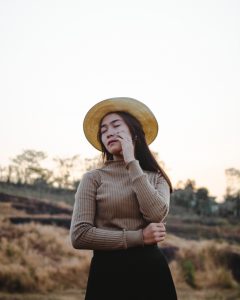Age spots are dark, brown, or flat dots on the skin. Given that they appear mostly on the areas exposed to open air (sun), some also call them sunspots. Other names include liver spots and solar lentigines.
Age spots can be dark, brown, or grey. They have rounded edges and increase the pigmentation and tanning of the skin.
You can differentiate between age spots and other conditions such as freckles by simply looking at their color. Age spots occur on your body parts that are mostly exposed to the sun – this mainly includes the back of hands, shoulders, top of feet, face, and back.
As their name suggests, age spots appear on the skin as people get older; generally, after 40. In any case, younger people can also get them.
A single ‘spot’ can be up to ½ inches. Age spots don’t need any medical care, but if you are confused between the spot on your skin and other conditions, you can always go to a medical center.
At times, age spots become slightly raised on your skin. Medically, it is called Seborrheic Keratosis. These spots can be yellow and brown. They are painless and benign (non-cancerous). Of course, raised age spots make the skin not look so good, but you still don’t have to worry about them medically.
Raised age spots start slowly and eventually become thicker and darker with time. They look like someone stuck them on the skin- like a gum.
A recent study found that dark spots are a bigger concern in Asian women than wrinkles.
Asian skin tends to be oilier than other skin. Due to a higher hydration level in the Asian skin, their melanocytes, the pigment-producing cells might not always produce and spread melanin evenly on the skin.
Melanin is the pigment that protects our skin from UV rays. Also, when a skin surface has more melanin than it requires, it darkens. This phenomenon is called hyperpigmentation.
Hyperpigmentation can sometimes progress to something other than age spots, such as Melasma. Melasma spots are bigger than age spots, and they also become more prevalent during pregnancy.
You see, Asian skin is different from other skin due to hyperpigmentation. This is why other skins have wrinkles when they age, but Asian skin has age spots. There is also another condition called hypopigmentation, in which the body’s immune system attacks pigment cells. It is caused mostly by vitiligo.
They may or may not be hereditary. And even if they are genetic, you can prevent them if you don’t expose your skin to the sun often. Moreover, hereditary age spots usually happen during early age.
Like we mentioned earlier, age spots happen because of hyperpigmentation; that is when there is more melanin on a certain part of your skin than needed. However, doctors aren’t really sure why hyperpigmentation happens in the first place.
Before talking about the treatments, we need to discuss how you can prevent age spots:

Yes, you can get rid of age spots. Although no one can guarantee that the spots will disappear completely, there are various procedures that can lighten the spots and make them unnoticeable. Regardless, the best way to cope with age spots is to prevent them from getting in the first place.
If you have age spots, the first thing you should do is to not worry. Remember, stress is a factor in every disease and condition, and you don’t want to make age spots a bigger concern than it actually is.
After all, age spots are natural spots that happen to many. They are there, but they don’t do any further harm to your body. So, you should stop overthinking or worrying.
That being said, there are many ways you can diminish or get rid of them:
For a condition such as this, home treatments are the most affordable and effective. Even if some of the treatments haven’t been ‘scientifically proven,’ experience says that they work.
You can smear the spots directly with aloe vera gel for thirty minutes in the morning and evening. Rinse thoroughly.
Age spots are yet another skin condition that apple cider vinegar can treat. Mix an equal amount of ACV and water in a bowl and apply it on the dark spots. Also, you can add lemon or some orange juice in the mixture. By the way, ACV with the mother apple is the best.
Instead of making lemon juice, slice a lemon in half and apply it to the dark spot. Leave it for ten minutes before rinsing. You can do it two times a day, and if your skin is sensitive, you should mix the juice with water just like ACV.
Similar to lemon, you can cut potato slices in half and apply it to the skin for 30 minutes. As they don’t have acid, they are the better option for sensitive skin. It’s best to do it twice a day, even if it’s more effective at night before bed.
Use a cotton swab or directly apply buttermilk or yogurt on the affected area and leave it for thirty minutes before rinsing. By doing this regularly, it will not only remove the spots but also brighten your skin.
You can make your own papaya skin lotion. To do this, remove the seeds off the green papaya and blend the flesh in a blender. Apply it over the dark spots and leave it for thirty minutes.
Have a well-balanced diet that includes all of the essential vitamins and nutrients. Only then can your body develop a strong immune system, which will aid the effectiveness of these age spot home remedies.

Medical treatments are more aggressive and, of course, more effective. Here are some ways dermatologists can help remove the spots:
In Laser therapy, a light beam of certain wavelengths is focused directly on the spots. You need to see your doctor two or three times, and it might take some weeks or months for the spots to fade away. The side effects of laser therapy include changes in skin color, pain, and in rare times, scarring, infection, and bleeding.
The dermatologist will apply a freezing solution (especially liquid nitrogen) on the affected area. This will make the spots milder and can discolor the skin. Cryotherapy is only useful for smaller age spots and can have side effects like skin irritation or permanent scarring.
Chemical peel means applying acid on your skin. It will remove its outer layer with the age spots, and new skin will grow in its place. Carrying the risk of permanent skin discoloration, you might need to visit the doctor several times, and your skin will redden after the treatment.
The concept is similar to that of a chemical peel, however instead of acid, a fast spinning brush is used. Dermabrasion is more intense than microdermabrasion and its side effects include scarring and redness.
Melanoma is the worst form of skin cancer. Usually, the difference between Melanoma and age spots is that the former has a more irregular border and can have more than one color.
Melanoma spots are more itchy, painful, and tender. The shape is like that of a ‘duckling,’ with one side being more irregular than the other. Also, melanoma spots can grow to be much larger than age spots. Remember that even if they are small, they can be equally problematic.
Depending on where the spots appear, you can identify the difference between the two. Age spots happen only in places that are regularly exposed to sunlight. Besides, they are more common in adults over the age of 40.
And if you have any concerns or doubts, you should always consult a medical professional.
Age spots aren’t medically worrisome or dangerous, but they can be very irritating. You don’t need to worry as they are only natural, and there are lots of treatments – both home and medical center-based – to get rid of them. Likewise, you should always visit the doctor if you think the lesion is more than just an age spot.
With love,
aspurely

Co-founder and Head of Research
Ms Ong has more than 25 years of extensive experiences in research and development, conceptualization, formulation, and production process development. She is currently the Head of Research and Development at aspurely skincare.
She has authored 2 best-selling Beauty and Wellness books with Marshall Cavendish, Nature’s Spa: DIY Beauty Treatments and Nature’s Treats: Recipes for Wellness, which are currently available in the Singapore National Library collection.
Ms Ong was also a Beauty columnist for Lianhe Zaobao, Singapore's largest Chinese-language newspaper publication, with huge regional presence. As its weekly expert contributor, she shared the latest research and technologies from the Beauty industry, and addressed many readers’ skincare issues and concerns, offered beauty tips, quick fixes and insider knowledge.
POPULAR POSTS
TAGS
DATE POSTED

when you sign up as a member to enjoy our aspurely Rewards!
*Terms and Conditions apply.
Exclusive perks for aspurely Rewards members.
Starter Pack, All Year Discount, Exclusive Privileges and more..
